The Land Rover Defender is – and has – a number of things almost nothing else is (or has).
First, it’s not just one thing. It’s your pick of several. Short or long wheelbase. Two or four doors. Two – or three rows of seats.
Or, skip the seats.
It also offers five different engines, ranging from a small four to a big V8.
That makes it a lot like things used to be.
The Defender is a compact-to-mid-sized luxury SUV that’s available in three different lengths and two different wheelbases, with either two or four doors and two or three rows of seats.
The two-door, short wheelbase Defender 90 P300 S starts at $56,400; it comes standard with a turbocharged 2.0 liter four. The 90 can also be optioned with either of two versions of a 3.0 liter turbocharged six cylinder/mild-hybrid combo or a 5.0 liter supercharged V8.
The four-door Defender 110 – which stickers for $60,600 to start for the P300 S trim – also omes standard with the the same 2.0 liter engine and is available with the same optional V6/hybrid drivetrains as well as the 5.0 liter V8.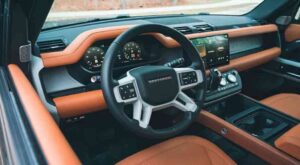
The Defender 130 – which stickers for $69,100 to start comes standard with three rows of seats. This version of the Defender comes standard with the 3.0 six/mild hybrid drivetrain – and can be optioned with the 5.0 liter V8. Land Rover offers an Outbound version of the 130 (base price $84,500) that comes standard with the V8 and deletes the third row to open up more cargo space.
The most luxurious version of the Defender is the 110 P525 Carpathia – which comes standard with the supercharged V8, a 15 speaker Meridian premium audio system, 22 inch wheels, a refrigerated front console beverage bin, heated windshield, three-zone climate control and unique-to-this-trim interior and exterior accents.
All Defenders come standard with a full-time automatic 4WD system with a two-speed transfer case and can pull at least 7,716 lbs. – even with the four cylinder engine.
What’s New for 2024
The Outbound trim (for the Defender 130) is new this year. There’s also an available County Exterior appearance package and there’s a new version of the 5.0 liter V8 available for the Defender 110 and 130.
What’s Good
Multiple body/seating configurations.
Multiple engines.
On-road manners; off-road capabilities.
What’s Not So Good
The 3.0 six and V8 engines are not available as stand-alone options; to get either, you must move up to much-more-expensive P400, P500 and P525 trims.
Touchscreen audio system interface isn’t as easy to use as traditional knob and button controls.
Standard 2.0 liter four uses about as much gas as optional V6 and V8 engines.
Base (P300) versions of the Defender come standard with a 2.0 liter, turbocharged four cylinder engine that makes 296 horsepower and 295 ft.-lbs. of torque, paired with an eight speed automatic transmission and a full-time 4WD system. This engine is strong enough to allow even the base trim P300 90 to pull as much as 7,716 lbs. – which is in the ballpark of a current half-ton truck’s towing capacity and very strong for such a small engine.
It’s all feasible because the Defender is remarkably light for what it is – just 3,870 lbs. for the two-door model. To put that in some perspective, the Nissan Ariya EV I reviewed last week – which is almost exactly the same size as the Defender 90 – weighs 4,323 lbs. Which is probably why the Ariya isn’t rated pull anything. Granted, the Ariya isn’t a beefy SUV. It’s an overweight EV. But that’s kind of the point I’m trying to make here. The Defender is a – and it still weighs about 500 pounds less than Nissan’s light-duty, on-road-only electric crossover.
The next-up engine is a 3.0 liter turbocharged six paired up with what’s referred to as a “mild hybrid” system, which just means the V6 gets cycled off when the Defender isn’t actually moving – or when it’s coasting/decelerating. This doesn’t appreciably reduce fuel consumption, per se, vs. the Defender’s standard 2.0 liter four – which rates 18 city, 24 highway vs. 17 city, 20 highway for the V6/hybrid combo.
What it does is provide significantly more power without significantly reducing fuel consumption.
There are two versions of the 3.0/hybrid combo. Defender 90 and 110 P400 trims get the strongest version, which makes 395 horsepower and 406 ft.-lbs. of torque. The long-wheelbase 130 is available with a version that makes the same horsepower (296) as the standard 2.0 liter four but significantly more torque (347 ft.-lbs.) Either way, a Defender so equipped is capable of pulling up to 8,201 lbs.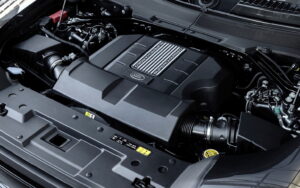
You can also a Defender with a 5.0 liter V8.
It is one of the largest – and strongest V8s that’s still available and the fact that it’s supercharged rather than turbocharged makes it different than almost every other V8 that’s still available in anything else.
The Mercedes G550, for instance, has a much smaller 4.0 liter V8 that needs a turbo to make 416 horsepower. The Defender’s supercharged V8 makes 518 horsepower – and it doesn’t cost $143,000. That latter being the base price of the Mercedes. (You can get more power in the Benz G than is available in the Defender, if you’re able to spend $183,000 to get it. That latter being the base price of the AMG G63, which has a 577 horsepower version of the turbocharged 4.0 liter V8.)
Interestingly, a Defender equipped with the available supercharged V8 is not rated to tow more than a Defender equipped with the V6/hybrid set-up is rated to tow. That probably has something to do with something else – besides horsepower – such as the current Defender’s unibody rather than body-on-frame construction.
But the V8-equipped two-door 90 can get to 60 in 4.4 seconds – more than twice as quickly as the old body-on-frame model.
There is also a slightly less mighty version of the 5.0 liter V8 that’s new for this model year and less pricey. It makes a still-stout 493 horsepower and you can get it in the 110 P500 for a comparatively inexpensive $93,000 vs. $110,000 for the strongest iteration in the 110 P525.
It is also available in the long-wheelbase 130 P500 for $116,00.
The Defender used to be one of the most capable off-road vehicles available. And it still is. But you wouldn’t guess that by driving it on-road. Put another way, it is not necessary to drive it with extra care, on-road – because it isn’t limited in its capabilities, on-road, in the way old Land Rovers (and real-deal SUVs generally) once were.
In their own way, the old-school SUVs were not unlike old-school muscle cars that were single-mission-oriented. They were designed to get to 60 and through the quarter-mile as quickly as possible and never mind how they cornered, stopped or rode on the highway. Those attributes weren’t the reasons people bought muscle cars. They bought them because they pushed you back in the seat when you pressed down on the gas.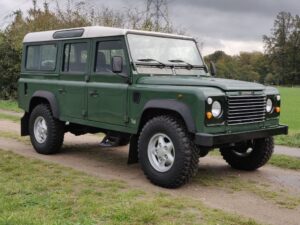
Similarly, real-deal SUVs were designed to rooster-tail their way through muddy creeks and claw their way up uneven terrain but once back on the road, they required you to slow down – especially for curves – so as to avoid ending up on two wheels (and maybe upside down). They weren’t especially confidence-inspiring on the highway, either.
This Defender is nothing like that. Or – rather – it is much more than that. It is probably more capable than its single-mission ancestors, mainly on account of advances in suspension (and tire) technology – while also being vastly more stable and comfortable wherever you decide to drive it. It has independent four wheel suspension with coil springs rather than solid axles and leaf springs, among other things.
So even though it has almost 12 inches of ground clearance and can ford 35 inches of water, you do not have to slow down for curves; you can take them at whatever the speed limit is – or even a little bit faster. You will not feel that you are pushing this rig beyond its limits by trying to keep up with highway traffic, either – because you aren’t. It takes deliberate recklessness to unsettle the Defender – and that’s not something that Land Rover or any other vehicle manufacturer can ameliorate via suspension or tire technology.
The standard four makes more power than the standard V8 that used to power Land Rover vehicles back in the mid-1990s and the current Defender 90 only weighs about 200 pounds more than its 1995 model year ancestor. This is a happy exception to the trend of the past 30 years that has seen the weight of the typical vehicle increase by more than 500 pounds.
The current Defender is arguably lighter than its ancestor in that – back in the day – a Defender 90 had a removable top. This Defender doesn’t (blame the feds and the regs for that) but if it did – and you took it off – it’d weigh less than its ’95 model year ancestor – while having a 100-plus horsepower advantage emanating from its 2.0 liter four vs. the ’95’s 3.9 liter V8 that made 182 horsepower.
Point being, it’s more than enough already. As opposed to barely adequate. The 3.0/hybrid combo that’s standard in P400 trims adds the one thing the four lacks – that being the sound of six rather than four cylinders. And the V8 makes the sound that makes the entire Persian Gulf stand up and cheer.
At The Curb
It looks like a Defender but it also looks new. This is not an easy thing to pull off. More often than not, attempting to recreate what was just remind us of what no longer is. (The current – and soon to be departed – Chevy Malibu being an example.)
This shows us what still is.
As you used to be able to do, you can get a Defender to suit you. The 180.5 inch-long 90 is the personal Defender; if you need a family Defender, the 197.5 inch-long 110 is the one. If you have a big family, there’s the 130 – which is 211.7 inches long and comes standard with a third row of seats and seven-passenger capacity. And if you have a big dog, there’s the Outbound iteration of the 130, which deletes the third row to make space for your 180 pound Great Pyrenees. A removable rubber cargo mat makes it easy to wash out the mud and fur, too.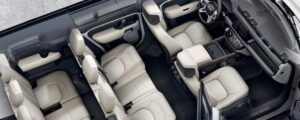
The two-door 90 is available with a first row third row – so to speak. You can opt for a flip-down middle seat that allows three to ride up front.
An interesting little detail about the three iterations of the Defender is that the smallest of them – the 90 – has the most front seat legroom – 40.6 inches vs. 39.1 inches in the 110 and 38.4 in the 130. Of course, you can always slide the front seats back a little if you need some more legroom – at the cost of taking some away from those behind you.
Inside, you’ll find even more iterations – of places to put your things. There are extremely handy cubbies built into a dashboard shelf that runs the length of the dash and several others built into just about every other surface Land Rover could carve out a nook or cranny to make space. Super handy to toss keys or whatever you don’t want to keep in your pockets.
The main gauge cluster is an LCD screen but it’s not of the too-much-information variety. It displays the vital readouts and in analog-style gauges. But the really big news – as Ed Sullivan used to say – is that there isn’t a Pop Tart-style tablet screen erupting out of the dashboard – as is becoming common in so many new vehicles. Instead, there’s a much-more-discreet 11.4 inch rectangular secondary screen that is neatly tucked into the dashboard, where it does not get in the way of your view ahead or dominate the view of the vehicle’s interior.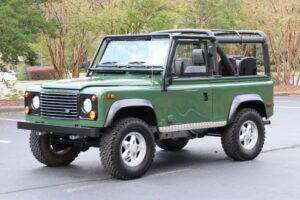
The current Defender isn’t available with a removable top, as already mentioned. But it does come standard with a huge, panorama sunroof. All Defenders also come standard with a full-size spare properly mounted on the rear liftgate – where you can get to it without getting underneath the vehicle. The base trim also comes standard with an excellent Meridian 10 speaker premium audio system, power heated front seats, heated and power folding outside rear mirrors and a wireless charging pad with a built-in signal booster.
You can take it from there with an array of additional/available features, including an air suspension system that allows tailoring of ride height/ground clearance and an even better 15 speaker Meridian audio system.
One the other things you can’t get in a new Defender – in the United States – is the diesel engine you can get in Defenders sold in other markets, due (once again) to federal regulations.
It’s a diesel-hybrid, too.
This combo averages 33-plus MPG. Too bad we’re not allowed to buy it.
Some good news, though. For 2025, it appears LR will offer twin-turbo V8 in the Defender you can buy here, in a new Octa trim.
Just be prepared to dig deep.
The Bottom Line
The Defender has always been a lot of fun because it has always offered a lot of capability – and personality.
It still does.
And more of the same.
. . .
If you like what you’ve found here please consider supporting EPautos.
We depend on you to keep the wheels turning!
Our donate button is here.
If you prefer not to use PayPal, our mailing address is:
EPautos
721 Hummingbird Lane SE
Copper Hill, VA 24079
PS: Get an EPautos magnet or sticker or coaster in return for a $20 or more one-time donation or a $10 or more monthly recurring donation. (Please be sure to tell us you want a magnet or sticker or coaster – and also, provide an address, so we know where to mail the thing!)
If you like items like the Baaaaaa! baseball cap pictured below, you can find that and more at the EPautos store!






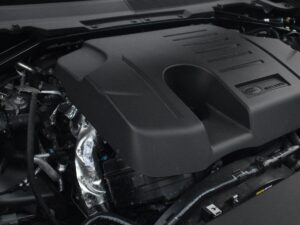









Who thought it was a good idea to give it pimples on the back? I guess the same guy who designed the previous iteration that was asymettrical.
Hi Steve,
They’re trying (LR) to make something different – stylistically, too. I like that they are trying – because it’s not easy given the parameters imposed on all vehicle manufacturers. This rig is one of the few that stands out; maybe not everyone’s stylistic cup of tea but at least it doesn’t look like (and isn’t like) everything else!
Saw one of these in person both ways now, I have to admit the lights look pretty cool with clear lenses/red LEDs and some offroad gear on the roof.
Safety
Dynamic Stability Control (DSC) with Roll Stability Control (RSC) Electronic Stability Control (ESC) And Roll Stability Control (RSC)
Electronic Traction Control (ETC) ABS And Driveline Traction Control
Side Impact Beams
Dual Stage Driver And Passenger Seat-Mounted Side Airbags
360 Parking Aid Front And Rear Parking Sensors
Blind Spot Assist Blind Spot
Emergency Braking
Lane Keep Assist Lane Keeping Assist
Lane Keep Assist Lane Departure Warning
Aerial View Camera System
Collision Mitigation-Front
Driver Monitoring-Alert
Low Tire Pressure Warning
Dual Stage Driver And Passenger Front Airbags
Curtain 1st And 2nd Row Airbags
Airbag Occupancy Sensor
Power Rear Child Safety Locks
Outboard Front Lap And Shoulder Safety Belts -inc: Rear Center 3 Point and Pretensioners
Back-Up Camera
Front Camera
Left Side Camera
Right Side Camera
500HP Jaguar Land Rover 5.0L Supercharged AJ V8 Teardown…a look inside….
https://www.youtube.com/watch?v=0MUHCvskzOQ
Eric,
The 6 cylinder turbo engine is the Ingenium straight six, it’s not a V6.
The V8 powered one will sound great and is far safer then any lithium ion battery powered EV…
One defective lithium-ion battery cell just killed 22 people…they are so dangerous they should be banned….
https://www.youtube.com/watch?v=5UhvEdqzPXE
That plant makes disposable lithium batteries, like the Energizer AA/AAA lithium available here.
Not rechargeable lithium batteries.
You’ll need plenty of this in your Land Rover maintenance supply:
https://cybermotorcycle.com/gallery/electrics/Lucas-wiring-smoke.htm
We’re the “crown of thorns” family of collectors, a ‘85 Defender 110, a ‘04 Disco G4 (apparently rare, the “Global Challenge” edition in orange), and me, gramps, with a 2018 Harley. So far no one has been stranded out on the road, the 110 ignition died in our driveway – no start when the kids were leaving after dinner. I drove it for a time, one incident the fuel pressure regulator let go 1 block from home spewing gas all over lucky no fire.
What the hell is that ugly ladder hanging down behind the left side door? Some dude on YouToob explains:
https://www.youtube.com/watch?v=oScXfNMH6bs
I could easily design a folding ladder to slide completely under the roof rack, eliminating this clunky, wind noise-making protuberance.
Rover probably thinks it looks tough, manly, authentic. I think it looks blazingly stupid. Like something that might appeal to architecture critic King Chas. Maybe that’s the King Chas Balmoral edition depicted in the photo, with all the Beverly Hillbillies shooting-brake bric-a-brac piled haphazardly athwart the roof rack.
If gifted this vehicle, I will remove its comically oversized wheels and park it on concrete blocks in my front yard. Then I will seat myself in a retro plastic-webbed folding lawn chair, and gaze at my ironic artistic statement whilst consuming a Pimm’s Cup. Life of Riley, innit.
For the American market that ladder is going to need to be at least three times wider.
k’k’k’
If Grand Cherokee does not offer the new I6TT Hurricane engine next time we need one, this car will be high on our list. Thanks for the review Eric.
The only problem I see for us is limited dealer locations, both are 1hr+ from us.
If you have three oil wells pumping 100 barrels per day and selling at 50 dollars per barrel, you’ll be hauling in 15,000 USD per day, at 75 USD per barrel, 22,500 USD per day. You can be able to afford a couple of Defenders.
ExxonMobil loves every minute of it. Air Force One is full of jet fuel.
When I see a private jet take flight, it means millions of dollars of oil revenue every day.
Texas has some 187,000 oil wells pumping an average of 13 bpd.
Do the math. Natural gas wells bring the total to more than 1,000,000.
13 x 187,000 = 2,431,000 bpd, it’s easy.
Numbers matter, big numbers are where it’s all at.
Especially for those hydrocarbons.
Parents seem to love the 90, I saw a brochure where they keep the china/silverware at their house, and Dad’s been considering a few 4×4’s as he’s got new car fever.
They get one, I’ll mod it, since mom loves the aux lights on my Bronco (https://lucky8llc.com/collections/defender-2-lighting-1)
Fingers crossed they get one
Oh, man, I love it!
And what a treat, Eric, to not have to review another device! I can tell you enjoyed this one a lot.
Glad not every company has wussed out and made nothing but anemic engines and EVs. Those are great options and as you said at a shockingly lean weight for an SUV. Tesla Model 3s which are -sedans- are 4,000lbs!
The phrase “supercharged V8” just makes me smile. Especially in this land of weak 4 bangers and hybrids. Nice combo of road worthy acceleration / power and the required clearance, torque, and design to take it off road too. If I was in the market (and had the $$ which is the main problem as others have noted) this would be on the short list.
Great review Eric. I want this vehicle. Just need to rustle up $90,000!
The price tag on new cars is unreal.
Thanks, RS!
And: Same here…
Reminds me of the Chevy S10 and K5 Blazers and Suburbans…you could get them in 2 or 4 doors, with 4-bangers and V6s in the S10, and sixes and small and big block V8s in the K5 and Suburban, and 2WD and 4WD, and in the Suburban, 1/2 and 3/4 ton ratings.
They met your needs for personal, family, and big family transportation. I knew a family with 6 kids, a dog, a cat, and several fish that had one. You could fit all of them and their luggage in their 2500 series Suburban.
Can you still?
While this LR is nice, I prefer the old school Land Rovers that could literally go ANYWHERE! I like the no-nonsense, no BS nature of the old Land Rovers that you used to see on Wild Kingdom.
Yes the Defender purists (my son-in-law) were outraged when this thing came out. The purists refer to this generation as the Pretender.